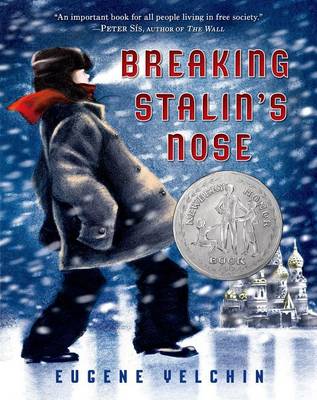Reviewed by Nicole Lynn on
I'm excited to be bringing you my thoughts on a "middle-grade" read today! This book was another read I had for class last semester, but I'm so happy I chose this one: Breaking Stalin's Nose by Eugene Yelchin. As I've been mentioning to almost everyone, I'm trying to explore/read more of this age-range. I've picked up a few books on my own through BookOutlet.com, have read some already for class, and explored my local library's shelves. I'm truly excited to delve into these books and read more outside of YA. If you have any recommendations, feel free to leave them below in the comments! For my quick thoughts on Breaking Stalin's Nose, please continue reading below!
Breaking Stalin's Nose, written and illustrated by Eugene Yelchin, follows 10-year-old Sasha Zaichik. Sasha has only known one way of life, one mindset. He's been preparing to become a Soviet Young Pioneer--showing his devotion to Comrade Stalin, the Communist Part and Communism--for most of his life. Now it's finally time to be sworn into the Young Pioneers, but suddenly things start going awry. Over a short few days, Sasha's world is turned upside down. Soon he beings to question his loyalty, the actions asked of him, and who he can really call an ally.
Yelchin does a wonderful job of bringing to life a story not usually told. It was really great to get this point of view of life for a boy living under Stalin and Communism. Yelchin provides great insight into the brainwashing and mindset of most of the people living under Stalin's rule as well as the huge amount of fear permeating the community. Readers see how easy it was for community members to believe in this way of life when it was something they were born into. Opposite that, readers also see how people tried to fight back to the communist rule. Telling the story from a 10-year-old's point of view really made this environment accessible.
Sasha, while somewhat of a stock character in that he was helping portray a lot of children living in communism, was still a wonderful character. Yelchin successfully develops Sasha's character and I loved seeing him grow into his own by the end of the novel. Sasha has to deal with a lot over a very short time period. He stumbles at first, but by the end of the novel he has learned to trust his instincts more. Yelchin does such a great job of creating Sasha and building the storyline together.
Furthermore, Yelchin does a great job providing secondary characters that present various points of view for those living in a communist country. Sasha encounters a lot of different characters whom he viewed in one way at the beginning of the novel. Readers get to see as Sasha's views of most of these characters change as he changes.
Finally, Yelchin's illustrations really add to the overall novel. Having the life-life, yet cartoon-styled pencil drawings brings the reader in and allows for more accessibility of the content being presented. My only real problem with novel was that I felt like it ended somewhat abruptly. Others that I spoke to in class about the book felt otherwise, but I think I just wanted more. I wanted to keep reading and I wanted to see how else Sasha planned to navigate life with his new mindset. While I do believe that this novel presents its message in full, I think I liked the novel so much I just wanted more. So, that's why the ending felt a little abrupt for me. Overall, I definitely would recommend this book to middle grade readers, especially if he/she/they were into historical fiction. I'd also recommend this book to be alongside any history lessons on the time period/topic.
Reading updates
- Started reading
- 23 March, 2016: Finished reading
- 23 March, 2016: Reviewed
